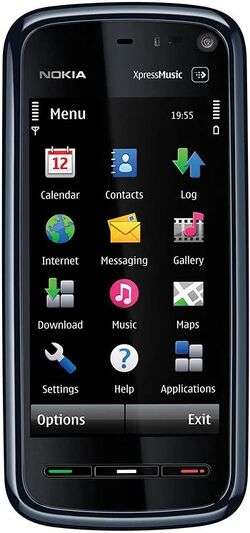Symbian

Android is like pissing your pants to keep warm in the winter.
—Anssi Vanjoki on why Nokia didn't adopt Android in favour of Symbian, MeeGo and later Windows Phone.
Previously known as EPOC, Symbian was developed by a joint venture between Psion and a consortium made up of phone manufacturers Ericsson, Motorola, and Nokia. Best known as the operating system which powered Nokia's smartphone line from the 2000s such as the 7650, 3650, the N-Gage and N95, Symbian, during its EPOC days, also previously saw use on various PDAs and handheld computers. The Ericsson R380 smartphone, released in November 2000, was the first device to be distributed with EPOC Release 5.1.
Symbian also introduced the concept of a separate core kernel and associated libraries, and an operating environment which provided a shell on top of the OS, not unlike early Windows versions. This allowed device manufacturers to come up with their own UI or license an existing interface like S60 (formerly known as Series 60), developed and used by Nokia for its own devices and later licensed to Samsung and Sony Ericsson or UIQ, a touch-centric interface utilised by a number of high-end smartphones by Sony Ericsson, Motorola, Arima and Benq (the BenQ P31 would later be rebadged as the Asia-only Nokia 6708, the only Nokia-branded device to use UIQ). Other shells include the little-used Series 80 and 90, and the Japan-only MOAP and OPP. The S60 Platform saw numerous editions during its lifetime—the first three were developed for phones with keypads, the first such device being the Nokia 7650 in 2002; the first Series 60 device to see a North American release is the 3650, sold in the States as the 3600, with the 3660 (released as the 3620 in North America) hardware revision released to address complaints about the 3650's keypad design. The Third Edition introduced mandatory code signing; a user may install only programs that have a certificate from a registered developer, making existing software from older S60 releases incompatible and also doubles as a (weak) form of Copy Protection. There was no S60 Fourth Edition in keeping with Nokia's deference to Asian markets due to tetraphobia; (Though strangely enough, while there are no 4xxx series Nokia phones, there is however the S40 platform for lower-end devices and the Nokia 3410.) the fourth major release was instead named Fifth Edition and was developed with support for touchscreens The latter release would later be developed into Symbian^2, Symbian^3, Symbian Anna and Symbian Belle.
While Symbian did become popular in the 2000s, it wasn't without its issues. Unlike custom Android shells by manufacturers like HTC Sense, Samsung's One UI, Amazon's Fire OS or Oppo's ColorOS, which while drastically different from one another are still compatible with apps made for mainline Android, applications written for one Symbian or EPOC distribution are incompatible with one another, leading to fragmentation and thus the burden of having to port games and apps to account for different Symbian varieties. It's even worse with the Japanese MOAP platform, which for whatever reason did not allow for any third-party applications at all, making it no better off than a dumbphone. The interface was seen by some as being cumbersome and confusing, particularly with language selection—one Russian reviewer lamented the unnecessarily complicated way of toggling between keyboard languages, slowing down text input.
Symbian was also notorious for being unstable, and the default S60 web browser ran far worse than competing browsers. Malware was also a problem, and Series 60 first and second-edition devices are prone to virus-laced .sis packages circulating through Bluetooth and/or MMS; this threat was mitigated by the fact that none of these viruses use any flaws within the operating system itself, instead relying on social engineering to convince unwitting users into thinking that the malicious app is a game or some other utility—the only time the poor user would know that his/her device is infected is if it suddenly racked up a costly phone bill for sending dozens of MMS messages in an attempt to further spread the virus. Later Symbian versions were far more secure thanks to code signing requiring developers to sign their apps for retail distribution, though they're not free from vulnerabilities either, and it also had the side effect of forcing some users to sort of jailbreak their devices in order to run pirated apps or other unsigned code. It also didn't help that there wasn't a centralised app store back then apart from Nokia's Ovi Store, placing the burden on the user who had to dig through either their wireless provider's media portal or at a shady warez site carrying cracked .sis packages.
But the final nail in the coffin came with the likes of Android and iOS. While Symbian did enjoy a 73% market share in 2006, lingering problems with the platform along with new players in the mobile space and in-fighting within Nokia, who was at that point maintaining the OS, eventually displaced Symbian to irrelevance and obscurity. Symbian did enjoy some significant market share in Europe and Asia, but not in North America where Nokia isn't as popular. Not even the touch-centric S60 5th Edition saved the platform, and by extension, Nokia, from its eventual demise—while the Nokia 5800 XpressMusic and later N97 were hyped to death by being featured in films and music videos, and touted as "iPhone killers" due to their touchscreen interface along with the N97 sporting a pop-up keyboard, they were saddled with numerous issues which led to Nokia's decline in the 2010s.
Not to be confused with sybian (if you're looking for something a little, um, pleasurable), symbion or symbiosis.